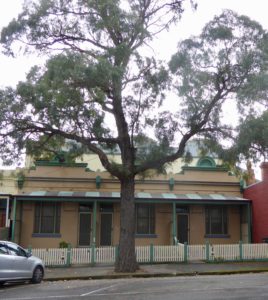- DOWNSIZING—DESIRABLE BUT NOT ALWAYS EASY
One last example, because it shows that changes in welfare policy were not uniform or consistent:
St Joseph’s Homes for Children in Flemington 1981-1997: the Family Group Homes era.
It’s probably true to say that, broadly speaking, child-savers like Selina Sutherland and those involved in the boarding-out movement were Protestant. Catholics seemed to prefer large institutions and were slower to change to small-scale facilities.
When St Joseph’s Home in Surrey Hills finally closed in 1991 after 90 years of congregate care, the long-term resident children were placed in foster care or hostels, and the staff moved to a row of shop fronts in Pin Oak Crescent, Flemington.

They intended it to be a drop-in crisis centre—with short-term accommodation for local families doing it tough. They also purchased houses in Finsbury Street for use as family group residential care.

Sister Mary Cavanagh commented that the children who came into these family group homes in Flemington came into care at a later age
so they were more damaged…And they weren’t really wanting to be part of a family and were often very destructive and difficult. It was very difficult to get them to settle into a family set-up where they were competing with the couple’s children.[1]
Clearly the Josephites, who were long accustomed to stricter institutions, were facing problems with the children in these more open settings.
Moreover, St Joseph’s—conceived as a localised service—found itself taking children from all over the inner suburbs of Melbourne. Some expressed concern that the government was pushing too hard for family reunification.[2]
The Christian Brothers took control of the homes in 1991. The Brothers were determined to set a new direction for their child welfare system. Ultimately, in July 1997, St Joseph’s Home for Children became part of MacKillop Family Services and, after providing a family support and counselling service, and disability service, MacKillop left the Pin Oak Crescent, Flemington address just a few months ago.
************
- Conclusion
I have looked at a handful of the more than 300 institutions in Victoria, large and small, that have looked after children at some time.[3] In the examples close to North Melbourne—and throughout the nation too—the trends in out-of-home care are clear.
In the modern era, residential care is the least common form of care for children in need of care and protection. The dominant form today is kinship care, followed by foster care.
Yet, questions remain: why remove children at all? And if the state decides to do so, must it be more than a temporary change in the life of the family?
At the start I pointed to proposition of the Legal Aid review in 2016:
that the removal of a child from the family is one of the most serious actions that the State can take, and should be a last resort.
I have discussed the purposes and motivations for separating children from their families in the examples close to North Melbourne. These motives have been mixed and so too has been the system—if we can call it that—a strange hybrid where intention and effect were not always close allies. To paraphrase Phillip Adams, the muddy footprints of welfare history are all over the carpet.
Whichever way you look at the OOHC system today, it is—as ever—in a state of crisis.[4] It is—and always has been—overstretched and in need of resources.
But more than anything it needs a more coherent purpose and rationale. It is self-evident that if the state removes children from their families, it must ensure that it provides a better environment for those children—not a worse one.
The Royal Commission and other inquiries have demonstrated that far too often the systems set up to protect children from abuse and neglect have themselves cause harm to children and their families.
My personal opinion is that the best interest of kids is to keep them with their families by supporting their families in tough times. If children must be taken out of their families for their immediate safety, the aim should be to work collaboratively with those families to get the children back as soon as it is reasonable to do so.
END
————————————————————————————-
[1] Jill Barnard & Karen Twigg, Holding on to Hope: A history of the founding agencies of MacKillop Family Services 1854-1997, Australian Scholarly Publishing, Melbourne, 2004, p. 284.
[2] Barnard & Twigg, 2004, p. 300, 307.
[3] Frank Golding for Melbourne Museum, with support of CLAN (Care Leavers of Australia Network: www.clan.org.au) and Find & Connect (www.findandconnect.gov.au).
[4] See Commission for Children and Young People, “…as a good parent would…”: Inquiry into the adequacy of the provision of residential care services to Victorian children and young people who have been subject to sexual abuse or sexual exploitation whilst residing in residential care, The Commission, Melbourne, 2015.
One thought on “Lost & Found: State Children in Victoria (6)”
Comments are closed.
Hello admin, i must say you have very interesting posts here.
Your page should go viral. You need initial traffic only.
How to get it? Search for; Mertiso’s tips go viral